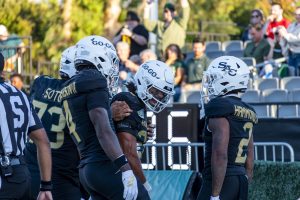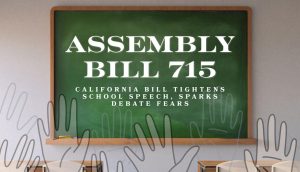Scaring ourselves way too much
October 30, 2002
Halloween comes from a long line of harvest spirit fests. When the world around us is dying in preparation for Winter’s rest, we tend to think of those who have died before us.
In the Celtic tradition, dead relatives were disinterred and their skulls reverently painted so they could be with the family during October feasts. Mexico’s D’a de los Muertos honors relatives through cleaning of gravesites and offerings of food. In the Germanic pagan tradition, taxes were collected in person this time of year, and this morphed into playful door-to-door begging called “guising.” In fact, in Northern Britain, the word for guest and ghost are the same thing, “geist.”
Later, when contact with the spirit world was discouraged, the night turned into frightening ghosts and spirits away. In the later 1800’s, the influx of other European cultures diluted the predominately British traditions, and it became a night of mischief.Stuart Schnieder reported in his book “Halloween in America” that vandalism, by poor and crowded urban dwellers, became a larger part of the holiday by the turn of the century. Simple vandalism of the nature of tipping outhouses had turned nasty by the 1920’s, with destruction of property and cruelty to animals.
Neighborhoods and civic groups like the Boy Scouts mobilized to organize safe and fun alternatives to vandalism. Good children were encouraged to go out and get treats from neighbors and shopkeepers. By the 1930’s the phrase “trick or treat” had become popular.
In the middle of this decade, Halloween was at its height. Decorations were scary, costumes were fun and wacky, and children were thrilled to be spooked with the threat of ghosts and spirits hovering in the chill night air.
Somehow, we have become too frightened to play scared on Halloween now. Decorations are usually a paper witch, and trick or treating takes place during the day to keep our kids safe. This is a real shame! Children especially have such a fine sense of fright caused by nothing. It’s such a blast!
No more apples given out, for the legend of a razor in the apple has been thoroughly lodged in the collective throat. A 1985 Washington Post poll found that 60 percent of parents feared their children would be injured or killed from Halloween candy. But when a University of Southern Illinois professor researched it he found no child had died, nor received a serious injury from Halloween candy.
We are all scared nowadays. We lock our doors and eye suspiciously the unshaven neighbor in his funky house clothes. Rationally, we don’t have the right to. The Justice Department found that crime dropped 10 percent between 1999 and 2000, and violent crime dropped 15 percent in that same year.
Mayor of Oakland, former governor Jerry Brown, writes that “In 1991, there were 571 crime stories; in 1993, they jumped to 1632-double the ’92 levels and triple the coverage of murder stories. But the crime rate didn’t change.”
Sociologist Barry Glassner’s anti-consumerist take on our immense fear factor “is that immense power and money await those who tap into our moral insecurities and supply us with symbolic substitutes.”
Frank Furedi, a British professor, thinks that it has to do with our individualistic culture leading to an increasing sense of alienation and lack of community; paradoxically creating not a strong individual but a “confusing and dangerous world.”
I think we’re hooked on fear. We’ve always told ghost stories. We are mesmerized by near death experiences, and the TV feeds this nicely by giving us plenty of violent images to be horrified at.
I remember coming home from trick or treating, and the stories we told my mom were of the scary things we had “felt” during the night. Plus, all the loot that we scored from enduring the spirit-laden night.
Don’t really be frightened this All Hallows Eve. Those are your friends and neighbors out there, not evildoers. And for goodness sake, turn off your T.V. for tonight so you can actually enjoy the harmless spook of a cold wind under your collar.
























































































































